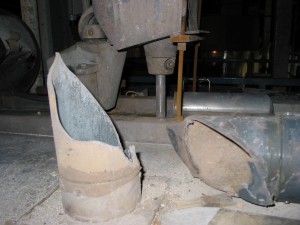At 9:30 am, an explosion ignited a fire inside a vent collection system (VCS) at a plating chemicals manufacturing and research facility. One employee was critically injured to eyes and face (chemical burns). Eighteen other employees were transported to Hospital for medical evaluation. The vent collection system was severely damaged, and plant operations were interrupted for several weeks.
In addition to evacuating plant employees, the Fire Department (CFD) ordered an evacuation of residents and businesses within 800 m of the facility because of concern that cyanide salts and acids stored in the plant might combine to create toxic hydrogen cyanide gas. The fire was extinguished by 11:40 and the fire-fighters left the scene at 1:00 pm.
The incident occurred on the vent collection system that was installed in 1990 during plant expansion and consisted of interconnected polyvinyl chloride duct segments, gradually decreasing in diameter, suspended approximately 6 m above the floor. The purpose of the system was to transport vapours, gases, and mists emitted from various processes to a scrubber. The system had undergone several changes from 1992 to 2003 (addition of vent ducts) that were designed and installed without engineering analysis.
The incident likely began when an employeesuspecting the plastic ventilation duct to be cloggedtapped on it with a small hammer. The hammer blow initiated an explosive reaction of the many different chemicals that had accumulated inside the duct (among which silver nitrate, silver cyanide, sodium hydrosulfite, ammonia ). The U.S. Chemical Safety and Hazard Investigation Board (CSB) investigated the case and determined the following root and contributing causes:
- the hazards associated with installing a vent collection system to handle the exhaust from multiple processes were not evaluated neither prior nor after the installation.
- no risk analysis was carried out when changes were made to facility processes and equipment (i.e., management of change). Significant changes made to the vent collection system were not envisioned in the original design and significantly deteriorated its performance. Such modifications should have been accompanied by a design and engineering review, a process hazard analysis, and before-and-after performance testing to ensure that the system was operating as intended.
- Emergency plans were inadequate, with little coordination with the CFD.
- No process and equipment integrity procedures or training to inspect or maintain the vent collection system were available.
The plant operator was advised to:
- implement formal process safety review procedures for projects involving chemical processesincluding the vent collection system,
- implement a management-of-change program and a preventive maintenance program including regular inspections and training,
- improve the facility’s emergency response plan including emergency response procedures and interface with the surrounding community and submit it together to the fire department for review.




